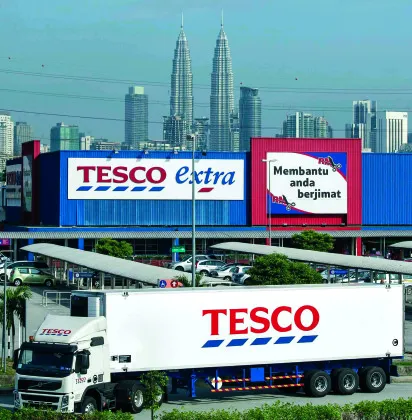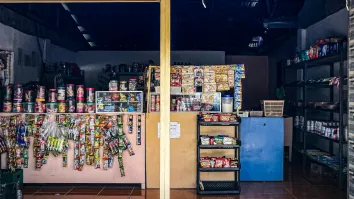
Testing time for Tesco: Lessons arising from the crisis
The year 2014 can be considered a watershed year for Tesco. Faced with a series of problems in the UK, its main market, the largest British retailer tried a series of solutions to resolve the crisis that culminated in the replacement of its CEO. Retail Asia asked Brian Moore, CEO of EMR-NAMNEWS Ltd, to share possible learnings for retailers in Asia.
We can’t talk about Tesco’s UK retail market problems without a brief overview of the main causes. What are the origins and how have they influenced the evolution of the national market? So, what is it all about?
Essentially, because of a combination of market pressures, Tesco has overstated its 2013-14 six-month profit statement by £263 million (US$396.5 million) in a period covering the past three years, resulting in a reduction of 93% in annual profits for the latest year. Profits to last August were down 91.9% to £112 million, compared to £1.3 billion a year earlier.
This has resulted in:
• The growing importance of the savvy consumer, demanding demonstrable value for money, unwilling to outsource their purchasing decision-making to marketers or retailers, ever again;
• A series of profit warnings leading to a £263-million profit forecast over-statement in half-year accounts;
• The replacement of CEO Philip Clarke and appointment of outsider Dave Lewis from Unilever;
• The suspension of four key senior managers, including the UK managing director ( … and more have left since the beginning of this year);
• A boardroom purge being conducted and two new non-executive directors appointed;
• Government investigations — the UK’s Financial Conduct Authority had begun an investigation into the accounting scandal, while the Financial Reporting Council was considering launching its own probe. These two probes have now been replaced by an investigation by the Serious Fraud Office as announced on October 29 last year; and
• A sell-off of a new corporate jet (Tesco’s new chief executive Dave Lewis had moved to head off shareholder anger over its new £31-million Gulfstream G550 executive jet by ordering its sale and the sale of its fleet of four aircraft.)
All of this resulted in a 50% fall in share-price, to a market value of £14 billion, its lowest value in 11 years.
By way of context, Tesco’s external debt is approximately £14 billion, which combined with a shortfall of £3.4 billion in its pension fund, means that it may have to sell off its Thai and Eastern European businesses, its research arm Dunnhumby and Tesco Bank for what analysts estimate could be a total of £10.5 billion, in order to significantly reduce debt and focus on rebuilding the business.
It was a shock to the UK that a company as large and as successful as Tesco could get it wrong, and this should be a lesson to retailers, and their suppliers everywhere, including Asia.
However, it is important to note that Tesco is on the ropes but not on the canvas ...
What will be the main impact of all these measures?
First, certain moves to increase profitability are off-limits.
In this situation, moving the supplier credit period from 40-plus days to 90 days, a potential cash-flow gain of approximately £5 billion would help, but would do little for enhancement of supplier relations.
Equally, any attempts to increase supplier trade investment or escalation of deductions would not only attract the attention of the authorities and media, for example, consumer, but would alienate suppliers, the essential collaborators in any recovery.
Given the current scrutiny by the authorities, it seems obvious that Tesco will be unlikely to rely upon increases in credit, trade investment, or deductions as cash generators. This means that the above-mentioned sell-offs are inevitable.
From Asian retailers’ point of view, I would think the above ‘short-cuts to profitability’ are also kept off-limits in their dealings with suppliers.
Globally, we believe in general, albeit with some exceptions, that there are five years of flat-line growth ahead, where growth in brands will only come at the expense of the competition.
As far as retail competition is concerned, other retailers will also have the same challenges, and grow only at the expense of other retailers. This means increased use of private label, a key differentiator in retail.
Before the 2008 global financial crisis, typical brand-private label split in the UK had evolved to 50/50 in a retailer’s offering. The past five years of flat-line demand resulted in a drift upmarket by affluent consumers and at the same time a downwards shift to the discounters, resulting in the ‘squeezed middle’, represented by the major multiple retailers.
These big players responded to shopper demand for lower prices and switching to more private label. This has resulted in a change in balance to 45/55 brand to private label.
However, if Asian retailers decide to make more private labels available in their assortments, it is important to note that Tesco’s success has been based on the Finest own label, where the quality is equal and often better than national brands, in order to satisfy savvy customers.
At the end of July last year, Philip Clarke, Tesco’s chief executive was shown the door after the company announced another drop in sales. Were market fluctuations a fundamental challenge to Tesco’s growth-based strategy?
Tesco in recent years became a ‘womb-to-tomb’ organisation, in that employees have tended to be ‘born with Tesco’ and ‘die with Tesco’, with company growth providing a desirable career-development environment for ambitious members of the team.
Tesco was founded in 1919 when entrepreneur Jack Cohen started selling surplus groceries from a market-stall in the East End of London. He handed over to his son-in-law Leslie Porter who is credited with developing the expertise of different departments in terms of purchasing, operations and marketing.
However, it was left to the succeeding CEO, team leader Ian MacLaurin, to pull the company together and focus on growth to No.1 in the UK.
Strategist Terry Leahy then took the retailer global, before handing over to Tesco-lifer Phil Clarke. Unfortunately, Clarke took command at a time when the chickens came home to roost for many retailers in the wake of the global financial crisis of 2008.
Up to this point, Tesco’s CEOs each made a unique and valuable contribution to a business that depended upon growth. Faced with years of flat-line demand, the company succumbed to a combination of internal and external pressures that severely challenged management’s ability to grow the business. Clarke thus became a high-profile casualty and was replaced by Dave Lewis from Unilever.
Again, Asian retailers will note that successful companies have to generate adequate ROCE performance, in turn driven by sales and profit, or suffer share-price reductions, and replacement of top management.
How true is it that Tesco became a driver of change in consumer behaviour?
Tesco was the original champion of the consumer, squeezing suppliers and competitors in order to sustain a ‘pile it high and sell it cheap’ strategy.
Gradually, the retailer became more sophisticated, and its growing 40,000-plus range was designed to satisfy more consumer needs in term of goods and services. This resulted in the development of out-of-town shopping where large-space superstores provided a one-stop shopping service for consumers prepared to drive for a monthly shop, and for increasingly exotic food products, both brand and private label (PL).
The company also pioneered online shopping and home delivery to cater for time-poor consumers. It could thus be said that Tesco were pivotal in raising and meeting expectations of the UK consumer. It also became very profitable in the process.
From an Asian perspective, it can be seen that, while large out-of-town retail space can generate scale economies and in-store theatre, other circumstances such as a weakening economy can cause consumers to save travelling costs by shopping closer to home.
The key is to anticipate the knock-on effect of market developments at local level.
Why is Tesco a reference brand in the UK?
From the early days of ‘pile it high and sell it cheap’, Tesco has been driven by a desire to place the consumer at the centre of the retail universe, bringing reasonably good product to the public at reasonably good prices. It also pioneered the use of PL, moving swiftly from basic foodstuffs through ‘me too’, to sophisticated competitor-products for leading national brands.
Tesco then introduced its “Finest” range, where quality was in a number of cases better than equivalent national brands, but at similar prices. This increased the appeal and credibility of the Tesco brand in the UK.
Incidentally, I believe that this brand strength helped Tesco to survive the ‘horse meat’ crisis, a set-back that would have been terminal for lesser retailers.
This comprehensive range of PL products, targeted to meet all consumer segments, helped Tesco to grow to a 50/50 brand/private label split that not only optimised differentiation and margin, but also became a PL standard for the industry.
I believe that there is a “dynamic equilibrium” in brand/PL share of 50/50 in most categories that will optimise differentiation and profit margin. Anything less in terms of private label means missed profit opportunities, anything more means possible confusion for the consumer, that is, the consumer needs national brands to ‘anchor’ the category.
PL success depends on being able to use a brand as a reference point in order to point out the advantages over the brand. Not having enough brands means the consumer cannot appreciate the advantages of the equivalent PL.
Loss in UK versus growth on international markets. Is this a reasonable trade-off for Tesco’s shareholders?
Any retailer hoping to be a successful global player needs to dominate its home market. With its 28% share, Tesco is still by far the UK’s largest grocery multiple retailer.
While shareholders should judge a company on the basis of the total business, in practice the ‘rule’ for success in global retail is that it is necessary to have a large, dominant share of the home market, allowing management to focus on growth in emerging markets.
Having developed the domestic business model, and securing, say, 25%-plus of the home market, the company can then roll the model out to other countries, and also provide career opportunities for ambitious staff who might otherwise be tempted to move to a competitor.
Any loss in the domestic market can become a drain on the overall business, apart from the dangers of applying quick-fix solutions that can have un-
intended consequences in terms of adverse media commentary.
In the Asian market, this combination of uncertainty concerning possible sell-offs and a struggle domestically means that Tesco’s Asian competitors could take advantage of their distraction in the short and medium term.
Tesco’s results do not represent a management crisis or even a redundant strategy as almost all players in the UK have problems. Is the rise of discounters also affecting the entire market?
This goes back to my point about ‘the squeezed middle’, a dilemma affecting all retail with the exception of the upmarket players like Waitrose, and the discounters at the lower end of the market. The major multiples such as Sainsbury’s, Morrisons and Asda (Walmart) are all suffering share loss at the expense of the discounters and Waitrose.
Essentially, with the exception of Asda to some extent, the multiples have failed to anticipate the swing to smaller, closer-to-home convenience retail, as the cash-starved consumers have searched for value amidst the austerity.
As a result, the major retailers are stuck with redundant large out-of-town space, with little real prospect of a return to the high growth of the early years of the decade.
The large-space retailers have over-
relied on scale economies and being able to spread store overheads, designed to meet consumer demand for monthly one-stop shopping. All of that has now changed as the market has undergone fundamental structural changes. These big ships have a lot of momentum, and will take time to change direction.
Small Asian retailers could benefit from these structural changes in the market by applying large-store KPIs to their business, becoming more efficient and placing themselves in a better position to resist the competition from the big guys that decide to move into the smaller local convenience market.
How about loyalty to supermarkets? Will it take time and will it be very difficult to bring back all customers?
I believe that one of the key casualties of the global financial crisis has been consumer loyalty to brands, PL and retailers. We are now in an era where a consumer demands demonstrable value for money, and has the means of comparing prices anywhere, but especially in the aisle, at the point of purchase.
Customers will not return unless retailers can meet these new criteria, and traditional supermarkets will be no exception. All I can say is that discounters rarely surrender market share in an economic upturn, and given the flat-line demand environment, supermarkets have a tough fight on their hands if they wish to regain share loss from the discounters.
New data is showing that recent sales at Aldi and Lidl were up 35% and 22% respectively, compared with the same time last year, while Tesco was down 1.9%. The discounters’ growing impact has pushed down food price inflation to its lowest level in eight years. How good is this strategy for the UK economy? It appears that the only strategy is a price war!
Deep down this is destroying value in brands, both supply and retail. In turn, this will lead to less incentive to invest in innovation. Weaker players will disappear through acquisition, or will simply be removed from the market.
In general, the consumer will benefit from lower prices and simpler purchasing, as duplication and overlap is eliminated from the market.
For sure, a price war is one way of providing growth for the big guys, at the expense of the less powerful players. This will also result in more government interference, and generally lead to less choice on the shelf. But it will also lead to more innovation, as retailers seek new ways of doing business, especially via multi-channel access to the consumer.
For Asian retailers and suppliers, the starting point has to be the [savvy] consumer, via a combination of Product, Price, Presentation and Place that is demonstrably better than the alternatives, made available to them however, whenever and wherever they choose to buy, resulting in a degree of satisfaction that causes them to willingly return for more and hopefully tell their friends … and all at a level of profit that satisfies the key stakeholders, thus avoiding the need for a price-war.
Tesco is only the visible part of the iceberg. What is happening now in the UK can be a warning signal for all supermarkets. How fast can they adapt their strategies or is it already too late?
The signs have been there since 2008, the global financial crisis, so the supermarkets have already had six years to recognise the obvious and change their strategies in these unprecedented times.
However, the changes in the market have been so fundamental, not all have been able to adapt fully. We still have trouble in the pipeline. The key thing, however, is that opportunities exist for those that are prepared to accept the new conditions as the norm, and act decisively, while their competitors await a return to the normal ways of doing business.
After a generation of dominance, life seems to be suddenly pretty tough for supermarkets. It is an overall scenario, in almost all important European markets. How can you explain this sudden reversal in fortunes?
In my opinion these changes are based not only on prices. The discounter’s format is much more flexible, with smaller outlets, limited numbers of personnel and a high proportion of private or surrogate labels. On the other hand, discounters want to meet more consumer needs by increasing assortments, with more articles, many of them with high added value, some close to premium.
Their low-cost model can be an inspiration to Asian retailers, in that they are continually focused on reducing costs and eliminating excess, yet giving the consumer what she wants, every time.
The discounters are offering limited choice but are not confined to limited quality. The market tolerates limited assortment in discounters, based mainly on PL versus Tesco’s model with thousands of articles. The discount model works and seems to be much more profitable. Does the answer lie in the consumer’s search for simplicity?
We are all seeking simplicity and are even becoming suspicious of complexity that we cannot understand. The discounters reached this point by intuition, and had the courage to back their hunches.
In fact, each model can be profitable, provided each retailer sticks to the model’s key criteria. In other words, discounting success depends on a limited range, in a small retail space with minimum overheads, whereas supermarkets and superstores depend on a large comprehensive range of brands and PL, scale economies and a high level of store traffic.
Consumers want simple, direct and transparent offers, or will vote with their feet and shop elsewhere.
What about promotions? Every Day Low Prices versus Discounters strategy, with weekly promotions, with a lot of in-out articles?
In the past, we spent years building up relationships with consumers and customers, on the premise that a strategic approach to brand optimisation produced a predictable and acceptable return on investment, growing a level of brand equity that would carry us over the troughs in demand.
This all changed with the 2007-08 global financial crisis and the emergence of the savvy consumer, gradually morphing into the savvy buyer, each unwilling to outsource their purchase decision-making to marketers and retailers, in a continuous search for demonstrable value-for-money, for each purchase.
The results are evident in the successes of Aldi and Lidl at the expense of Tesco and the other multiples. We are now as good as yesterday’s sales results, everywhere.
Any supplier attempting to build up a continuous relationship with the discounters, soon realises that life in this channel consists of a series of one-off initiatives, each bearing little or no relationship with previous moves made with the retailer. In fact, thinking about it, the same now holds true for dealings with the major multiples — the over-rider agreement is now seen as ineffectual and is fast becoming increasingly discredited as the row about commercial income, also known as trade investment,
escalates ...
Perhaps, this is how it should be in business. And if this is the case, perhaps all branded manufacturers should target Aldi and Lidl with one-off experiments to help their colleagues become accustomed to discontinuity, developing skills that can then be applied, hopefully with even more effect, via their traditional customers, making each initiative ‘the best ever’, as if our livelihood depended upon it … as it probably does.
In these changed circumstances, price has become but one part of the total offer package. The lesson here for Asian retailers is to look afresh at each offer and initiative, forgetting history, and instead make a judgment based upon their latest readings of the market, and go for it.
Tell us about Tesco’s home delivery service. Is it a good tool to fight discounters?
For those time-poor consumers who want a delivery to the home, Tesco at the right price will always be more appealing than the discounters. In fact, Tesco operates the world’s most successful grocery online service, but even in this case there are limits to the premium that a consumer is willing to pay for home delivery in terms of prices charged and delivery fee.
The dilemma for Tesco is that while it charges £5 for a home delivery, the actual cost to Tesco is allegedly £20 per delivery. This means that the company loses more as the use of home delivery becomes more popular.
Lidl has announced that it plans to open more stores in the coming years. In this regard, Lidl is much more flexible, being part of a family business. On the other hand, Tesco’s investment plans need shareholder’s approval.
The influence of third parties, that is, shareholders, will always impact the strategy of a publicly-listed retailer. However, even in the case of private companies, the members will want the company to generate an acceptable return on investment, if only to secure pensions for those involved and their families.
While most moves can be made in secret by a private company, in the end the economic problems are the same for private and public companies, and will eventually reach the surface.
Can neighbourhood convenience stores be a solution against discounters?
Local stores that can offer convenience at reasonable prices with the right products can compete with the discounters. The way forward for supermarkets that want to adopt discounter strategies is to allocate special discounter-aisles that replicate the normal 1,400 lines of a typical discounter, and charging slightly more for other lines that the consumer needs.
The Sainsbury’s-Netto approach is an experiment whereby they are keeping the discounter offering at arm’s length to avoid shopper confusion. If it works, fine. If it fails, little harm is done to the Sainsbury’s brand.
What other European markets are vulnerable to the British scenario?
In my opinion, all countries in the Eurozone are in trouble in terms of economics and politics. The euro is proving to be an unsustainable currency model.
This means that the changes in the UK retail market will cause pressures on all retailers to boost their stock-market performance, causing retailers to try to save money by offering less rather than more variety in meeting consumer needs.
Moreover, the savvy shoppers’ increasing access to price-comparison and social media means that it will be increasingly difficult for problems to be restricted to local areas. As a result, I see all markets being challenged by Tesco-related issues and having to adapt, or suffer loss of business.
As far as Asian markets are concerned, it is important to be very sensitive to slowdowns in market growth, given that most traditional business models are based upon ever-growing markets, resulting in high stock market expectations, which then cause pressure on bottom-line performance.
What is happening now in the UK is a good lesson for all European and Asian retailers. Are we going to see some changes in their future strategies?
The global financial crisis is resulting in austerity. Consumers are reverting to daily, even one-meal shopping, and are less willing to drive out of town to be tempted to buy more products in large-space retail outlets.
All retailers will need to focus on the needs of consumer-shoppers who are demanding demonstrable value-for-money, and are making their own purchasing decisions in terms of when and where they shop.
These savvy consumers are unwilling ever again to outsource these decisions to retailers, in the case of private labels — or even suppliers, in the case of brands. These are fundamental changes that I believe are permanent within most existing markets, and retailers will have to adapt, or suffer loss of market share.
What about “discounter prices”?
The key issue is the consumer-shopper’s attitude to what a product is worth. In the past, they would then factor in the shopping experience, namely, ambience, theatre, ease-of shopping, and range of sizes and types available, when they were willing to pay a little more for products in a supermarket and/or hypermarket.
Austerity means that the shopper is now less willing to pay a premium for these ‘extras’. Therefore the price gap between the same product in different channels or retail formats will almost disappear.
Given that these market conditions (that is, flat-line in demand) will probably continue for a further five years, retailers with larger outlets will either have to find ways of reducing prices via internal efficiencies, or lose share to smaller outlets.
This has to be the same for Asian markets.
There are rumours about a non-aggression pact between Tesco and Carrefour in some European markets. There is the Hungarian example, with a very powerful Tesco and the Romanian one, with Carrefour and no Tesco. Can Romania be an interesting market for Tesco?
First, the UK Serious Fraud investigation of Tesco, coupled with the appointment of GSCOP Adjudicator (Grocery Trade Code Of Practice), are symptoms of a growing worldwide trend towards government monitoring of grocery retailers’ relationships with suppliers, because of the possible impact on prices charged to the consumer, and possible limitations of choice.
For this reason, any ‘pacts’ between retailers would represent high risk for the parties involved. However, because of the speed of retail market reaction, it can be possible for competing retailers to closely monitor each other’s shelf prices, and by making minimal adjustments to their own prices, gradually build some price equilibrium in the market, and thus minimise the potential damage of all-out price wars.
In terms of Tesco in Romania, it has to be said that this crisis in the UK has caused Tesco to move into survival mode, reviewing all its activities in the UK and globally. I believe that this means Tesco will re-prioritise its global ambitions in terms of sell-off of parts of the business in order to focus on investing in large emerging markets as a priority.
This means that smaller markets have moved down the radar for Tesco, meaning that it is likely that Romania faces at least a five-year delay in any Tesco activity, in my opinion. In the short term, Tesco may however increase the use of its private labels via third-party retailers to safely develop a local presence and brand franchise in preparation for any upturn in the market.
I see these same issues impacting the retail sector in Asia, especially when governments wish to legislate for retailing locally, it would be easy to adapt the UK model, rather than re-inventing the wheel. Therefore, keeping an eye on how Tesco handles the Senior Fraud Office (SFO) investigation has to be a benefit for retailers in the region.
Talking about the SFO investigation, the main reason the problem arose was the habit in the UK retailing of booking suppliers’ trade investment monies in advance of achieving results, resulting in possible distortions in reported profit.
Given the growth of ‘trade funding’ or what the retailers call Commercial Investment or back margin, from something like 5% of a supplier’s sales 20 years ago, to current levels of 20%-plus, with relatively little in the way of robust results-based documentation, and inadequate tie-in between cause and effect in terms of timing and results achieved, it can be seen that the Tesco profit overstatement was an accident waiting to happen.
The SFO investigation of Tesco’s treatment of Commercial Income will rule that these significant sum-transfers in the supplier-retailer relationship need to be the subject of better controls, equivalent to those already in place to justify expenditure of similar sums in the factory, in terms of making capital investment decisions.
Possibly the most important take-away lesson for Asian retailers is to bear in mind that the SFO investigation and its equivalents in other retailers will force these long-overdue changes in how suppliers and retailers calculate and account for discretionary monies. It would obviously be preferable if suppliers and retailers introduced such disciplines at their own pace and on their own terms, rather than await their imposition by a government agency following a crisis.
Finally, is this the beginning of the end for Tesco?
Frankly, although Tesco is on the ropes, it is certainly not on the canvas.
It is still a major global player, with a good market share in many countries, a new, highly focused management team, under the leadership of a consumer-focused CEO, with the potential support of suppliers in all categories who want Tesco to succeed.
Hopefully, most of its issues are now exposed — and will be dealt with in a businesslike way.
In fact, on January 8 this year Tesco’s new CEO, Dave Lewis, announced his turnaround plan, resulting in an immediate 20% rise in share price. All Tesco needs now is time and money to make the necessary changes.
In other words, Tesco is now poised to continue its global growth with the benefit of having experienced the downside, and survived. In fact, rather than this being the beginning of the end, I would instead describe it as the end of the beginning for Tesco.
Brian Moore is chief executive of EMR-NAMNEWS Ltd, a marketing/sales consultancy, training and publishing company working in the grocery and pharmacy retail sectors.
The company publishes NamNews, a global newsletter for Account Managers, with over 5,000 subscribers, and KamCity.com, a website providing news, tools and information for KAMs/NAMs, and related departments working in the FMCG retail/manufacturing industry. Brian’s Kamblog is at www.kamcityblog.com
Following a key account and marketing career at Sandoz-Wander (ethical & OTC pharma) and Wella Hair Cosmetics, Moore has over the past 30 years conducted a wide variety of consultancy and training projects (Trade Marketing, Finance, Key Account Management, Category Management, Global Customer Planning and Management) for FMCG clients in the UK, Continental EU, C&E Europe, Middle East, Asia, Australia, and the Americas. Currently, he divides his time 50:50 between the UK and abroad.



















 Advertise
Advertise





